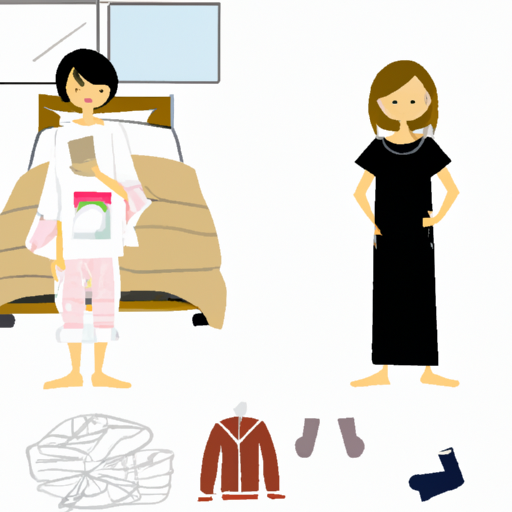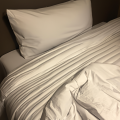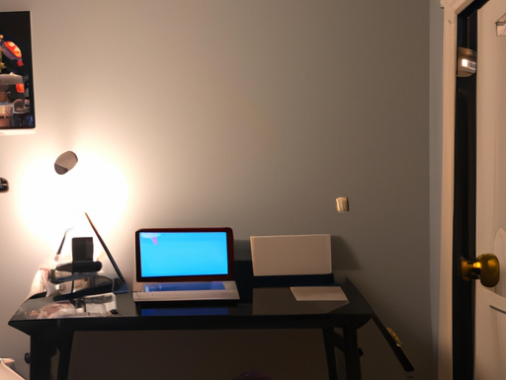-
Table of Contents
- Introduction
- How to Choose the Most Comfortable Outfit for Bedtime
- The Benefits of Wearing Comfortable Clothes to Bed
- The Best Fabrics for a Comfortable Night’s Sleep
- Tips for Creating the Perfect Bedtime Outfit
- The Pros and Cons of Wearing Pajamas to Bed
- How to Choose the Right Sleepwear for Your Body Type
- The Latest Trends in Bedtime Outfits and Sleepwear
- Q&A
- Conclusion
Introduction
When it comes to getting a good night’s sleep, comfort is key. The most comfortable outfit to wear to bed can vary from person to person, but there are some general guidelines to follow when choosing the perfect sleepwear. From cozy pajamas to lightweight nightgowns, there are plenty of options to choose from that will help you get a restful night’s sleep. In this article, we’ll discuss the different types of sleepwear and the benefits of each, so you can find the most comfortable outfit to wear to bed.
How to Choose the Most Comfortable Outfit for Bedtime
When it comes to bedtime, comfort is key. After a long day, you want to be able to relax and drift off to sleep in an outfit that is comfortable and cozy. Here are some tips to help you choose the most comfortable outfit for bedtime.
First, consider the fabric of your clothing. Natural fabrics such as cotton, linen, and silk are the most breathable and comfortable fabrics for sleeping. Avoid synthetic fabrics such as polyester and nylon, as they can be uncomfortable and cause you to overheat.
Second, think about the fit of your clothing. Loose-fitting clothing is best for sleeping, as it allows your body to move freely and prevents you from feeling constricted. Avoid tight-fitting clothing, as it can be uncomfortable and cause you to overheat.
Third, consider the temperature of your bedroom. If your bedroom is warm, opt for lightweight clothing such as a tank top and shorts. If your bedroom is cooler, opt for heavier clothing such as a long-sleeved shirt and sweatpants.
Finally, think about the color of your clothing. Darker colors absorb more heat, so opt for lighter colors such as white or pastels if you tend to get hot at night.
By following these tips, you can choose the most comfortable outfit for bedtime and ensure a good night’s sleep.
The Benefits of Wearing Comfortable Clothes to Bed
Wearing comfortable clothes to bed can provide a number of benefits. Not only can it help you to get a better night’s sleep, but it can also help to improve your overall health and wellbeing. Here are some of the key benefits of wearing comfortable clothes to bed.
Firstly, wearing comfortable clothes to bed can help you to get a better night’s sleep. Tight or restrictive clothing can be uncomfortable and can make it difficult to get comfortable in bed. Wearing loose-fitting, breathable clothing can help you to relax and drift off to sleep more easily.
Secondly, wearing comfortable clothes to bed can help to keep your body temperature regulated. Tight clothing can cause your body to overheat, which can make it difficult to sleep. Loose-fitting clothing can help to keep your body temperature regulated, allowing you to sleep more comfortably.
Thirdly, wearing comfortable clothes to bed can help to reduce stress and anxiety. Tight clothing can be restrictive and can cause feelings of discomfort and unease. Wearing comfortable clothing can help to reduce stress and anxiety, allowing you to relax and drift off to sleep more easily.
Finally, wearing comfortable clothes to bed can help to improve your overall health and wellbeing. Wearing comfortable clothing can help to reduce stress and anxiety, which can have a positive effect on your mental health. It can also help to improve your physical health, as it can help to keep your body temperature regulated and can help to reduce the risk of overheating.
In conclusion, wearing comfortable clothes to bed can provide a number of benefits. Not only can it help you to get a better night’s sleep, but it can also help to improve your overall health and wellbeing. Therefore, it is important to ensure that you wear comfortable clothing to bed in order to reap the full benefits.
The Best Fabrics for a Comfortable Night’s Sleep
When it comes to getting a good night’s sleep, the fabric of your bedding can make a big difference. The right fabric can help keep you cool and comfortable, while the wrong fabric can make you too hot or too cold. Here are some of the best fabrics for a comfortable night’s sleep:
1. Cotton: Cotton is a popular choice for bedding because it is lightweight, breathable, and soft. It is also hypoallergenic, making it a great choice for those with allergies.
2. Bamboo: Bamboo is a natural fabric that is soft, breathable, and moisture-wicking. It is also naturally hypoallergenic and anti-bacterial, making it a great choice for those with sensitive skin.
3. Linen: Linen is a lightweight fabric that is breathable and cool to the touch. It is also durable and wrinkle-resistant, making it a great choice for those who want a luxurious look and feel.
4. Silk: Silk is a luxurious fabric that is soft, lightweight, and breathable. It is also hypoallergenic and temperature-regulating, making it a great choice for those who want a cool and comfortable night’s sleep.
5. Wool: Wool is a natural fabric that is breathable and temperature-regulating. It is also naturally hypoallergenic and moisture-wicking, making it a great choice for those who want a cozy and comfortable night’s sleep.
No matter what fabric you choose, make sure it is comfortable and breathable. This will help ensure that you get a good night’s sleep and wake up feeling refreshed and ready to take on the day.
Tips for Creating the Perfect Bedtime Outfit
1. Choose comfortable fabrics: When selecting a bedtime outfit, it is important to choose fabrics that are comfortable and breathable. Natural fabrics such as cotton, linen, and silk are ideal for sleeping in as they are lightweight and allow your skin to breathe.
2. Opt for loose-fitting clothing: Loose-fitting clothing is more comfortable and allows for unrestricted movement while you sleep. Avoid tight-fitting clothing such as jeans or leggings as they can be restrictive and uncomfortable.
3. Consider the weather: Depending on the season, you may want to choose an outfit that is appropriate for the weather. In the summer, lightweight fabrics such as cotton or linen are ideal, while in the winter, you may want to opt for thicker fabrics such as flannel or fleece.
4. Layer up: Layering your clothing can help to keep you warm and comfortable while you sleep. Consider wearing a tank top or camisole with a long-sleeved shirt or sweater.
5. Accessorize: Accessories such as a cozy pair of socks or a soft scarf can help to keep you warm and comfortable while you sleep.
6. Choose colors that are calming: Colors can have a powerful effect on our moods, so it is important to choose colors that are calming and soothing. Soft pastels, neutrals, and muted tones are ideal for creating a relaxing atmosphere.
The Pros and Cons of Wearing Pajamas to Bed
Wearing pajamas to bed is a common practice for many people, but it is important to consider the pros and cons of this habit before making it a regular part of your nighttime routine.
Pros
One of the main advantages of wearing pajamas to bed is that it can help you feel more comfortable and relaxed. Pajamas are designed to be loose-fitting and breathable, which can help you stay cool and comfortable while you sleep. Additionally, wearing pajamas can help you feel more secure and protected, as the fabric can provide a sense of warmth and coziness.
Another benefit of wearing pajamas to bed is that it can help you maintain a sense of privacy. Wearing pajamas can help you feel more covered up and less exposed, which can be especially beneficial if you share a bedroom with someone else.
Cons
One of the potential drawbacks of wearing pajamas to bed is that they can be restrictive and uncomfortable. If your pajamas are too tight or made of a material that is not breathable, it can make it difficult to move around and get comfortable. Additionally, if your pajamas are too loose, they can become tangled and bunched up, which can be distracting and uncomfortable.
Another potential downside of wearing pajamas to bed is that they can be difficult to clean. Pajamas are often made of fabrics that require special care, such as hand-washing or dry-cleaning, which can be time-consuming and expensive.
In conclusion, wearing pajamas to bed can have both advantages and disadvantages. It is important to consider the pros and cons before making it a regular part of your nighttime routine.
How to Choose the Right Sleepwear for Your Body Type
When it comes to choosing the right sleepwear for your body type, there are a few key factors to consider. First, you should think about the type of fabric that will be most comfortable for you. Different fabrics can provide different levels of warmth and breathability, so it’s important to choose something that will keep you comfortable throughout the night.
Second, you should consider the style of sleepwear that will best flatter your body type. If you have a larger frame, you may want to opt for a loose-fitting nightgown or pajama set that will provide plenty of coverage. If you have a smaller frame, you may want to choose something more fitted that will show off your curves.
Finally, you should think about the color and pattern of your sleepwear. Darker colors can be slimming, while lighter colors can be more flattering. Patterns can also be used to draw attention away from certain areas of your body.
By taking the time to consider these factors, you can ensure that you choose the right sleepwear for your body type. With the right sleepwear, you can look and feel your best while getting a good night’s rest.
The Latest Trends in Bedtime Outfits and Sleepwear
Sleepwear and bedtime outfits have come a long way in recent years. From traditional nightgowns and pajamas to stylish loungewear and sleepwear sets, there are now a variety of options to choose from when it comes to getting ready for bed. Here are some of the latest trends in bedtime outfits and sleepwear.
One of the most popular trends in sleepwear is the two-piece sleepwear set. These sets typically include a top and bottom, such as a tank top and shorts, or a long-sleeved shirt and pants. They are often made from lightweight, breathable fabrics such as cotton or bamboo, and come in a variety of colors and patterns. They are perfect for those who want to look stylish while still being comfortable.
Another trend in sleepwear is the loungewear look. This look is all about comfort and style. Loungewear typically consists of a loose-fitting top and bottoms, such as a hoodie and joggers. It is often made from soft, cozy fabrics such as fleece or jersey. This look is perfect for those who want to look stylish while still being comfortable.
Finally, there is the classic nightgown. Nightgowns are a timeless sleepwear option that never goes out of style. They are typically made from lightweight fabrics such as silk or satin, and come in a variety of colors and patterns. They are perfect for those who want to look elegant and sophisticated while still being comfortable.
No matter what your style is, there is a sleepwear option out there for you. From two-piece sets to loungewear to classic nightgowns, there are plenty of options to choose from when it comes to bedtime outfits and sleepwear. So, go ahead and find the perfect look for you!
Q&A
1. What is the most comfortable outfit to wear to bed?
The most comfortable outfit to wear to bed is typically a pair of loose-fitting pajamas or a nightgown. It is important to choose an outfit that is made of breathable fabrics such as cotton or bamboo to ensure maximum comfort.
2. What type of fabric is best for sleeping in?
The best fabric for sleeping in is a breathable fabric such as cotton or bamboo. These fabrics are lightweight and allow your skin to breathe, which helps to keep you cool and comfortable throughout the night.
3. Is it better to sleep in loose-fitting clothes or tight-fitting clothes?
It is generally better to sleep in loose-fitting clothes as tight-fitting clothes can restrict your movement and be uncomfortable. Loose-fitting clothes also allow your skin to breathe, which helps to keep you cool and comfortable.
4. Is it better to sleep in long sleeves or short sleeves?
It is generally better to sleep in short sleeves as long sleeves can be restrictive and uncomfortable. Short sleeves also allow your skin to breathe, which helps to keep you cool and comfortable.
5. Is it better to sleep in shorts or pants?
It is generally better to sleep in shorts as pants can be restrictive and uncomfortable. Shorts also allow your skin to breathe, which helps to keep you cool and comfortable.
6. Is it better to sleep in socks or bare feet?
It is generally better to sleep in bare feet as socks can be restrictive and uncomfortable. Bare feet also allow your skin to breathe, which helps to keep you cool and comfortable.
7. Is it better to sleep with a blanket or without a blanket?
It is generally better to sleep with a blanket as it helps to keep you warm and comfortable throughout the night. It is important to choose a lightweight blanket that is made of breathable fabrics such as cotton or bamboo.
Conclusion
The most comfortable outfit to wear to bed is ultimately up to personal preference. Some people prefer to sleep in loose-fitting pajamas, while others may prefer to sleep in a t-shirt and shorts. Ultimately, the most important factor is that the outfit is comfortable and allows for a good night’s sleep.




